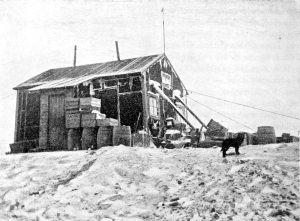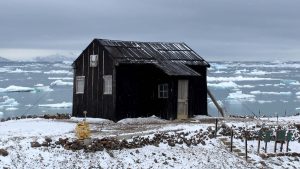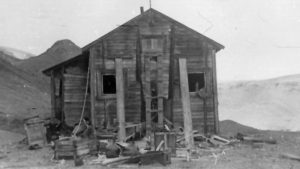 Nordenskjöld’s Hut aka Nordenskjöld House (64°21’49” South, 56°59’ 30” West) is a log hut built in February 1902 by the main body of the Swedish South Pole Expedition led by Otto Nordenskjold, who used the Snow Hill island (aka Cerro Nevado island) on the east coast of the Antarctic Peninsula as a base to explore the surrounding areas between 1901 and 1903. Currently, the Argentine Republic administers it as the Sweden refuge.
Nordenskjöld’s Hut aka Nordenskjöld House (64°21’49” South, 56°59’ 30” West) is a log hut built in February 1902 by the main body of the Swedish South Pole Expedition led by Otto Nordenskjold, who used the Snow Hill island (aka Cerro Nevado island) on the east coast of the Antarctic Peninsula as a base to explore the surrounding areas between 1901 and 1903. Currently, the Argentine Republic administers it as the Sweden refuge.
Since July 26, 1965 Refugio Suecia is a National Historic Monument of Argentina, by decree No. 6058/1965 and as part of the Province of Tierra del Fuego , Antarctica and South Atlantic Islands. It is also protected by the Antarctic Treaty, which designated it a 38th Historic Site and Monument, through ATCM VII-9 designation of 1972 and following a joint proposal between Argentina and the UK to the Antarctic Treaty Consultative Meeting
 The Argentine Navy took possession of the Refuge on January 8, 1954, renaming it Refugio Suecia and proceeded to its restoration. On that day the frigate Captain Luis T. De Villalobos, commander of the transport ARA Bahia Aguirre, took possession of the Refuge facilities on behalf of the Government of the Argentine Republic and recorded the new name. On the same day in its vicinity the Betbeder Naval Shelter was built. The Hut was used as a base for reconnaissance research in the summers of 1953-1954 and 1954-1955. In the early 1960s it had a warehouse with provisions for three people for three months.
The Argentine Navy took possession of the Refuge on January 8, 1954, renaming it Refugio Suecia and proceeded to its restoration. On that day the frigate Captain Luis T. De Villalobos, commander of the transport ARA Bahia Aguirre, took possession of the Refuge facilities on behalf of the Government of the Argentine Republic and recorded the new name. On the same day in its vicinity the Betbeder Naval Shelter was built. The Hut was used as a base for reconnaissance research in the summers of 1953-1954 and 1954-1955. In the early 1960s it had a warehouse with provisions for three people for three months.
The Refuge has been restored by the Argentine Antarctic Institute. It is enabled as a Museum and contains original objects of the expedition. Its conservation is carried out by Argentina and Sweden.
History
On February 12, 1902, the Swedish Antarctic Expedition led by Otto Nordenskjöld arrived on Cerro Nevado Island aboard the sailboat Antarctic provided with an auxiliary steam engine. The Captain of the ship was Carl Anton Larsen.
 The leader of the expedition had to spend the winter on the island along with meteorologist Gösta Bodman, sailor Gustav Akerlund, all of them of Swedish nationality, and Argentine Josè Maria Sobral, ensign. They would carry out meteorological, magnetic, astronomical and hydrographic work, as well as expeditions on the sea ice to the neighboring islands and to the nearby area of the Antarctic Peninsula, a region later known as the Nordenskjold Coast, and which extends to the southwest of the island.
The leader of the expedition had to spend the winter on the island along with meteorologist Gösta Bodman, sailor Gustav Akerlund, all of them of Swedish nationality, and Argentine Josè Maria Sobral, ensign. They would carry out meteorological, magnetic, astronomical and hydrographic work, as well as expeditions on the sea ice to the neighboring islands and to the nearby area of the Antarctic Peninsula, a region later known as the Nordenskjold Coast, and which extends to the southwest of the island.
On the northeast coast of the island a prefabricated wooden hut was mounted, covered externally with cardboard sheets ember bounded.
and
